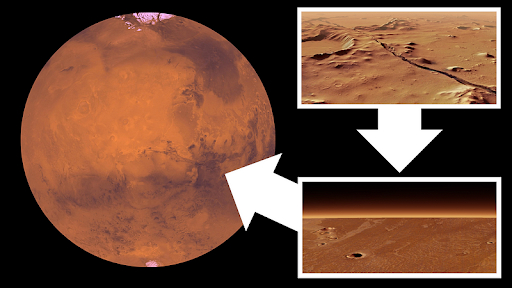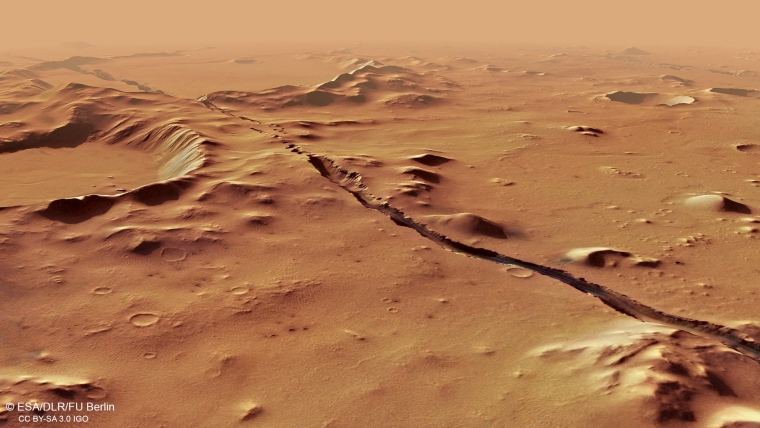
A team from the University of Arizona's Lunar and Planetary Laboratory has used spacecraft images and data from ground penetrating radar to create 3D reconstructions of lava flows in Mars' Elysium Planitia. The researchers discovered that lava likely erupted through fissures as recently as one million years ago, covering a region on the Red Planet about the size of Alaska.
The team uncovered over 40 volcanic events, the most massive of which seems to have filled a Martian valley called Athabasca Valles with almost 1,000 cubic miles (4,168 cubic kilometers) of basalt. These findings could have implications for Mars' ability to harbor life as we know it.
"Elysium Planitia was volcanically much more active than previously thought and might even still be volcanically alive today," team co-leader and Lunar and Planetary Laboratory scientist Joana Voigt said in a statement. "These areas that used to be considered featureless and boring, like Elysium Planitia, [they are] open books that provide a wealth of information about how they came to be if you know how to read them.
"I think they contain a lot of secrets, and they want to be read."
Related: Mars' atmosphere swelled like a balloon when solar wind stopped blowing. Scientists are thrilled
Mars is red, not dead
Unlike Earth, Mars lacks plate tectonics. Plate tectonics refers to the sections on our planet's crust that constantly shift and resurface, causing volcanic activity to occur at hotspots where plates meet or slide underneath one another. That means the Red Planet has often been classed as a "dead" planet that is geologically inactive. Recent discoveries on Mars, however, have challenged this idea.
Though no active volcanism has been observed on the Red Planet, while operating between 2018 and 2022, the NASA InSight lander showed the arid world is frequently rocked by "marsquakes," suggesting its interior must be far from inactive.
Only last year, another team of University of Arizona scientists showed evidence that an area of increased temperature magma called a "mantle plume" under the Elysium Planitia area has been driving intense seismic and volcanic activity over the recent past.

To conduct this new study and build a 3D model of such activity, the Lunar and Planetary Laboratory team took images from the Context camera onboard NASA's Mars Reconnaissance Orbiter (MRO) and high-resolution images from the MRO's HiRISE camera, combining these with data from the Mars Orbiter Laser Altimeter on NASA’s Mars Global Surveyor and with subsurface radar measurements collected by NASA's Shallow Radar (SHARAD) probe.
This allowed them to look as deep as 460 feet (140 meters) below the shell of the Red Planet, creating a 3D view that showed what the region was like prior to the eruption of lava from fissures.
"Our study provides the most comprehensive account of geologically recent volcanism on a planet other than Earth," said Christopher Hamilton, team co-leader and scientist in the Lunar and Planetary Laboratory, . "It is the best estimate of Mars’ young volcanic activity for about the past 120 million years, which corresponds to when the dinosaurs roamed the Earth at their peak to the present."
Implications for water and life on Mars
The team's findings have implications for the quest to discover if Mars could have once harbored microbial life. Water is a key ingredient for life as we know it, and scientists know that contrary to the barren and arid Red Planet we see today, the Martian surface once flowed with abundant liquid water.
Elysium Planitia is believed to be a region that once experienced large floods of liquid water, and there is evidence that when lava poured into this region, it interacted with that liquid water — or, at the very least, water ice. This interaction would have dramatically sculpted the landscape of Elysium Planitia.
The Lunar and Planetary Laboratory team found abundant evidence of steam explosions that would have occurred where the potential water met lava. This kind of interaction can give rise to hydrothermal environments — regions where water is heated by geological activity. Examples of this here on Earth include seabed fissures called hydrothermal vents, which are able to sustain a vast array of life forms.
Thus, locating regions of hydrothermal activity on Mars could also help pinpoint regions that would have been conducive to microbial life.

The volcanic activity seen by the team in the Elysium Planitia region may have also brought potentially life-sustaining water to Mars's surface in two ways. Firstly, a catastrophic amount of groundwater could have been released by volcanic eruptions, and secondly, water contained in lava could be flung into the atmosphere, where it froze and then eventually fell back to the ground as ice.
"When there is a crack in the Martian crust, water can flow onto the surface," Hamilton said. "Because of the low atmospheric pressure, that water is likely to literally just boil away. But if there’s enough water coming out during that period, you can get a huge flood that comes through, racing over the landscape and carving out these huge features that we see."
Further, understanding how water once flowed on the surface of Mars could also be important when considering crewed missions to the Red Planet.
Equatorial regions such as that of the Elysium Planitia are much easier to land on than regions at higher latitudes. Knowing water can be found in these areas, even if it is below the surface, could help future astronauts source water for consumption or for generating fuel during missions.
The team will continue to study this region, taking advantage of swathes of data collected using different imaging methods and creating more 3D insights into the Martian surface and regions that lie below. This will also help scientists construct a time sequence of events for other volcanically active regions of Mars.
"Elysium Planitia is the perfect location to try to understand the link between what we see at the surface and the interior dynamics that manifested itself through volcanic eruptions," Voigt said. "I paid a lot of attention to the details on the lava surfaces to try and untangle the different eruption events and reconstruct the entire history of these geologic entities."
The team’s research was published on Dec. 15 in the Journal of Geophysical Research: Planets.






